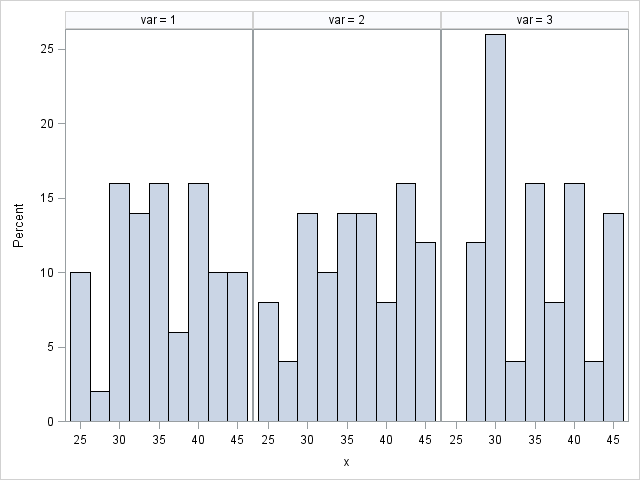- Home
- /
- Programming
- /
- Graphics
- /
- Three variables in a single graph
- RSS Feed
- Mark Topic as New
- Mark Topic as Read
- Float this Topic for Current User
- Bookmark
- Subscribe
- Mute
- Printer Friendly Page
- Mark as New
- Bookmark
- Subscribe
- Mute
- RSS Feed
- Permalink
- Report Inappropriate Content
I want to show the distribution of three variables Preop__Hct,Postop__Hct_Day_1,Postop__Hct_Day_2 in one graph. i'm using the following code.
in the output, the values on x-axis and Y-axis are displayed as the values of these three varaibles are super imposed on one another.
what to do so that i can clearly show the distribution of three variables in one single graph.
title 'Preop,DAY1,DAY2 HCT';
goptions nodisplay;
axis1 order=(0 to 100 by 5) value=(h=2) label=(h=2);
proc univariate data=research noprint;
var Preop__Hct;
histogram Preop__Hct / normal(noprint color=red)
nobars
name='PREOPHCT'
midpoints=20 to 45
vscale=count
vaxis=axis1
height=2;
inset normal(mu sigma) / pos=nw header='PreopHCT' height=2;
run;
quit;
proc univariate data=research noprint;
var Postop__Hct_Day_1;
histogram Postop__Hct_Day_1 / normal(noprint color=blue l=20)
nobars
name='DAY1HCT'
midpoints=20 to 45
vscale=count
vaxis=axis1
height=2;
inset normal(mu sigma) / pos=ne header='DAY1HCT' height=2;
run;
quit;
proc univariate data=research noprint;
var Postop__Hct_Day_2;
histogram Postop__Hct_Day_2 / normal(noprint color=GREEN l=20)
nobars
name='DAY2HCT'
midpoints=20 to 45
vscale=count
vaxis=axis1
height=2;
inset normal(mu sigma) / pos=n header='DAY2HCT' height=2;
run;
quit;
goptions display;
/* Replay the graphs into the same template */
proc greplay igout=work.gseg nofs tc=sashelp.templt template=whole;
treplay 1:PreopHCT 1:DAY1HCT 1:DAY2HCT;
quit;
run;
- Mark as New
- Bookmark
- Subscribe
- Mute
- RSS Feed
- Permalink
- Report Inappropriate Content
hi ... if you want to stick to the above approach, try a different template (though not sure if the graphics will look distorted)
there are four, sas-supplied templates in the sashelp.templt library you can try: v3, v3s, h3, h3s
proc greplay igout=work.gseg nofs tc=sashelp.templt template=v3;
treplay 1:PreopHCT 2:DAY1HCT 3:DAY2HCT;
quit;
- Mark as New
- Bookmark
- Subscribe
- Mute
- RSS Feed
- Permalink
- Report Inappropriate Content
I tried. Can we still plot graphs on one set of x and y axis values?
say for instance x axis will values 20 to 45 and y axis will have values 0 to 100 and we would want to see how the three varaibles are distributed over these x and y axes.
- Mark as New
- Bookmark
- Subscribe
- Mute
- RSS Feed
- Permalink
- Report Inappropriate Content
hi ... I have not used the SG procs much, but here's an example that I think does something like you want ...
data test;
do var = 1 to 3;
do j = 1 to 50;
x = ceil(20*ranuni(999)) + 25;
y = ceil(100*normal(999));
output;
end;
end;
drop j;
run;
ods html path='z:\' file='test.html' (url=none);
proc sgpanel data=test noautolegend;
panelby var / layout=columnlattice;
histogram x;
run;
ods html close;
it produced the attached

- Mark as New
- Bookmark
- Subscribe
- Mute
- RSS Feed
- Permalink
- Report Inappropriate Content
Using Mike's code, you can make a RowLattice to compare the distributions, or overlay each variable on the same plot:
data test;
do var = 1 to 3;
do j = 1 to 50;
x = ceil(20*ranuni(999)) + 25;
output;
end;
end;
drop j;
run;
ods html close;
ods graphics / reset width=3in height=5in imagename='MultiHist_RowLattice';
title 'Comparative Histograms';
proc sgpanel data=test noautolegend;
panelby var / layout=rowlattice;
histogram x;
rowaxis offsetmin=0;
run;
data test2;
do j = 1 to 50;
x1 = ceil(20*ranuni(999)) + 25;
x2 = ceil(20*ranuni(999)) + 30;
x3 = ceil(20*ranuni(999)) + 35;
output;
end;
drop j;
run;
ods graphics / reset width=5in height=3in imagename='MultiHist_Overlay';
title 'Comparative Histograms';
proc sgplot data=test2;
histogram x1 / transparency=0.7;
histogram x2 / transparency=0.7;
histogram x3 / transparency=0.7;
yaxis offsetmin=0;
xaxis display=(nolabel);
run;
This second version works better with SAS9.3 where you can control the bins. Or, with SAS 9.2, you can use GTL to do that.
here is a related article: Comparative Density Plots
Images attached.


April 27 – 30 | Gaylord Texan | Grapevine, Texas
Registration is open
Walk in ready to learn. Walk out ready to deliver. This is the data and AI conference you can't afford to miss.
Register now and lock in 2025 pricing—just $495!
Learn how use the CAT functions in SAS to join values from multiple variables into a single value.
Find more tutorials on the SAS Users YouTube channel.
SAS Training: Just a Click Away
Ready to level-up your skills? Choose your own adventure.



